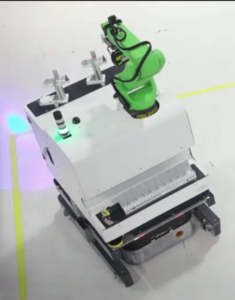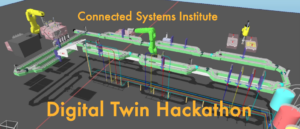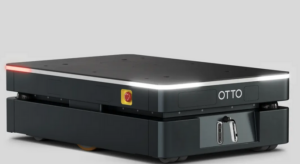🗓️ Starts: March 21, 2024, 9:00 a.m. 🕖 Ends: April 22, 2024, 9:00 a.m.
💻 Environment: Online 🎤 Presentation: April 26, 2024, 1:00-4:00 at CSI
🏆 $5,000 🏆
Prizes
One team will win a fully-funded trip to Anaheim, California, to present your solution at Automation Fair in November! Up to $5,000 in cash prizes and gifts will be awarded to winners! Categories include:
- Most innovative solution
- Best simulated solution
- Best video presentation of the solution
- Best return on investment (ROI)
The Challenge
 Problem Statement: CSI seeks to optimize its vial-filling advanced manufacturing testbed. The testbed, while partially automated, relies on human interaction for loading and unloading vials onto the production line. This dependence on manual labor restricts production to the standard 8-hour workday, Monday through Friday. Moreover, the constant presence of humans on the production line triggers safety features, causing the line to slow down, further impeding efficiency. CSI wishes to implement an AMR (autonomous mobile robot) fixed with a collaborative robot arm as part of the solution.
Problem Statement: CSI seeks to optimize its vial-filling advanced manufacturing testbed. The testbed, while partially automated, relies on human interaction for loading and unloading vials onto the production line. This dependence on manual labor restricts production to the standard 8-hour workday, Monday through Friday. Moreover, the constant presence of humans on the production line triggers safety features, causing the line to slow down, further impeding efficiency. CSI wishes to implement an AMR (autonomous mobile robot) fixed with a collaborative robot arm as part of the solution.
Objective: The objective of this hackathon is to devise an ideal solution to optimize CSI’s vial-filling advanced manufacturing testbed. The solution should aim to minimize human intervention, maximize production uptime, and enhance overall efficiency, while considering various possible improvements based on the criteria provided.
Solution Requirements: Teams are encouraged to provide solutions for as many of these requirements as possible, but it is not mandatory to solve them all in order to participate and be competitive. Showing progress toward a solution is acceptable.
- Efficient Solution: Develop an integrated system that optimizes vial loading and unloading onto the production line using an AMR with a robot arm, ensuring minimal downtime, efficient movement, and maximum ROI. This includes path planning, spatial constraints consideration, charging station placement, and other automation options or alternative solutions.
- Continuous Operation: Design a system that allows the production line to operate continuously beyond standard working hours, thus maximizing output and productivity.
- Return on Investment: Provide a calculation that demonstrates how long it will take for the investment in optimization to yield a return.
Benchmarks and Deliverables
March 21: Self-paced training begins in FTH
April 1: Last day to register to participate. Target date to complete E3D training.
April 8: Flowchart illustrating the preliminary concept for your solution due
April 22: Simulation due
April 25: Pre-recorded presentation due
April 26: Live presentations and awards at CSI
Evaluation Criteria
- Efficiency of the proposed solution in minimizing human intervention and maximizing production uptime.
- Clarity and thoroughness of the ROI analysis (This is where a business student on your team can help!)
- Overall innovation, feasibility, and scalability of the proposed solution.
- Professional quality of presentation video.
Note: Teams of up to 5 students are permitted, with the encouraged (but not mandatory) inclusion of one student from the Lubar College of Business for ROI analysis. The challenge aims to foster interdisciplinary collaboration and innovative problem-solving.
Eligibility
No experience working with digital twins is necessary! Train materials are included.
Undergraduate and graduate students currently enrolled at UWM may participate. Each team may include one student enrolled at another institution.
Team Size
1-5 students per team.
Registration
Registration is open and free! Registration closes on April 1.
Training: No prior experience necessary!
Training on Emulate3D is hosted on Rockwell Automation’s FactoryTalk Hub platform, where participants will have 24-7 access to the Emulate3D knowledge base and a suite of emulation/simulation tools. Training is self-paced, asynchronous, and will be available starting March 21. After registering, each team member will be enrolled into the FactoryTalk Hub platform and will receive an enrollment confirmation email with instructions for logging in and beginning training. Training is not mandatory, but recommended.
Hackathon Coaches
Each team will be assigned a coach, who is an employee on Rockwell’s Emulate3D team. Coaches will provide 45 minutes of office hours per team each week to meet and discuss questions and solutions.
Public Presentations: April 26
All teams who participate, whether your solution was successful or not, will be invited to present in person before an audience of industry partners, UWM faculty, and peers at the hackathon celebration! This is an opportunity to practice public presentations and network with professionals from industry!
Questions
Questions are welcome! Please email Casey O’Brien at caseyo@uwm.edu.
Acknowledgements
Thank you to Rockwell Automation and the members of the Advance Technology and Emulate3D teams for sponsoring and supporting this event!
Terms
The digital simulation used for the CSI Emulate3D Hackathon remains intellectual property of Rockwell Automation. No Hackathon participant shall copy or distribute any part or portion of this model without Rockwell Automation’s written consent. Participants cannot claim or have rights to intellectual property resulting from work produced within this hackathon. Rockwell Automation makes no guarantee or warranty whatsoever resulting from use of Rockwell Automation Technologies. Rockwell Automation, CSI, and UWM shall be able to use any information, development or knowledge gained from the events of the hackathon at their discretion.

 This hackathon challenges participants to enhance the efficiency of CSI’s advanced manufacturing testbed by leveraging a digital twin to implement an autonomous robot to load and unload materials, thereby reducing human labor and optimizing production. Participants will have one month to tackle this task, receiving guidance and support from Rockwell’s team through training and coaching sessions. No experience with digital twins is necessary!
This hackathon challenges participants to enhance the efficiency of CSI’s advanced manufacturing testbed by leveraging a digital twin to implement an autonomous robot to load and unload materials, thereby reducing human labor and optimizing production. Participants will have one month to tackle this task, receiving guidance and support from Rockwell’s team through training and coaching sessions. No experience with digital twins is necessary!
